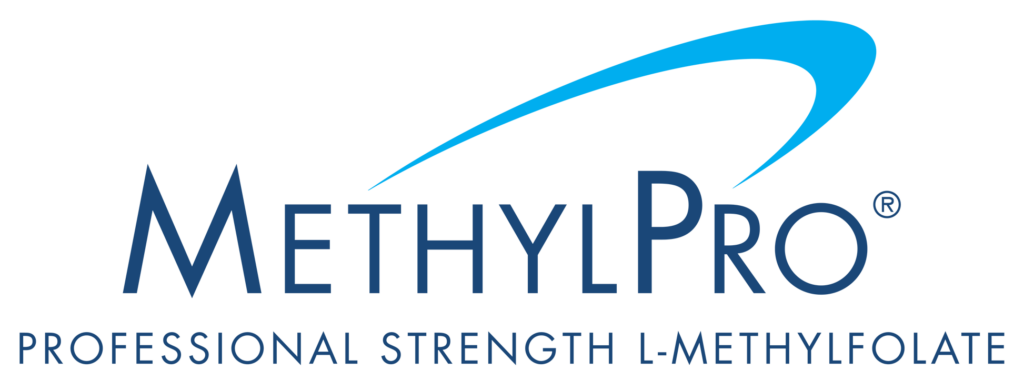Folate is an essential nutrient, meaning it must be consumed from the diet. But what foods are high in folate?
It can be found naturally in some foods (such as spinach, asparagus, beans, and citrus fruits) and in fortified foods that contain the synthetic form of folate, known as folic acid. Ideally, our bodies would be able to utilize all of the folate ingested via food. Unfortunately, research suggests that the utilization, or “bioavailability” of dietary folate is less than that of supplemental folic acid due to additional chemical breakdown that is required.
Due to this discrepancy between how much folate we eat versus how much we can actually absorb and use, Dietary Folate Equivalents (DFE) have been established. Studies have determined that synthetic folic acid is 1.7 times more bioavailable than natural food folates [1,3].
However, derivatives of folates such as methylfolate (5-MTHF), may have even better bioavailability than folic acid with fewer potential adverse effects [2,4,8]. Specifically, methylfolate is less likely to mask a vitamin B12 deficiency or have specific interactions with medications, and it can benefit those with methylation polymorphisms [4,8]. The absorption and utilization of food folates and folic acid are also reliant upon optimal gastrointestinal (GI) health and the absence of genetic variants.
Where is folate absorbed?
Folate is primarily absorbed in the upper segment of the small intestine, called the jejunum, but lesser amounts of folate can be absorbed throughout the remainder of the small intestine and in the large intestine, also known as the colon [5]. Probiotic bacteria in the colon produce absorbable folates as well, further highlighting the importance of a healthy gut microbiome [6].
Before folate can be absorbed by intestinal mucosal cells, however, folate-containing foods must be fully broken down in the intestine. Then, free natural folate and folic acid can be converted into folate derivatives by various enzymes. The main folate derivative that enters the bloodstream is methylfolate, primed for cellular use throughout the body [1,2,6]. Some methylfolate may also travel to the liver for storage. Genetic variants that affect folate metabolism, such as methylenetetrahydrofolate reductase (MTHFR) polymorphisms, can hinder the availability of active folate needed by the brain, cardiovascular system, reproductive system, and for many other functions throughout the body.
Will taking medication affect my folate absorption?
There are multiple factors affecting folate absorption. Alterations to the GI tract can further impair the amount of folate available for circulation and storage. Below are a few examples of ways by which absorption can be affected.
GI Function
The health of your GI tract is the primary determinant of folate absorption. Various conditions can cause malabsorption and/or increase the probability of deficiency [1].
Key processes in folate absorption require specific pH levels. Because insufficient stomach acid or pancreatic enzymes can alter the pH of the GI tract, medical conditions affecting the stomach and pancreas can also decrease the amount of folate entering intestinal cells [3,7].
Medications
A number of medications are known to impair folate absorption and metabolism [1]. Antacids, H2 blockers, proton pump inhibitors, and bile acid sequestrants can all impact absorption due to alterations in GI pH. Some medications are even designed specifically to interact with folate. Due to these possible interactions, it is important to always consult with a healthcare practitioner when starting a supplement to determine individualized dosing recommendations.
Alcohol
Moderate and chronic alcohol use have been shown to decrease circulating folate levels [1]. This effect appears to be associated with a combination of low dietary intake of folate, poor absorption, increased excretion, and reduced uptake from the liver, leading to folate deficiency. Alcohol-induced injuries to the intestinal border reduce its ability to transport nutrients from the lumen of the intestine into necessary cells [6,9]. Storage of folate, which normally takes place in the liver, is either decreased or terminated completely with prolonged alcohol use.
Genetic Variants
It is estimated that between 60-70% of individuals have at least one MTHFR genetic polymorphism, which can translate to reduced production of functional MTHFR enzyme [7]. Once folate is absorbed into the mucosal cells of the jejunum, it must be activated to enter the bloodstream. Reduced ability of the MTHFR enzyme to produce active folate for methylation can lead to a number of maladies including cardiovascular issues, pregnancy complications, and mood imbalances, among other difficulties [1,2,7].
There are other genetic variants and autoimmune conditions that can disrupt the transport or binding of folate [6]. Dietary folates can even be destroyed before consumption due to the way a food is processed or cooked [2,5].
Can I increase my folate absorption?
The first step for optimal folate absorption is to heal the gut. The GI tract is a barrier between our bodies and the outside matter we take in, and optimal function is essential for healthy regulation. Reducing your intake of processed foods and increasing intake of organic, whole foods can provide more synergistic nutrients to be absorbed along with folate.
Research and scientific concern is growing in relation to the over-consumption of synthetic folic acid, as a build up of unmetabolized folic acid (UMFA) circulating in the bloodstream can have adverse health effects [2,4]. Supplementing with methylfolate may help to circumvent this complication, provide the bioavailable form of folate to those with genetic variants, and is well absorbed regardless of pH conditions [4,8].
References
- https://ods.od.nih.gov/factsheets/Folate-HealthProfessional/2
- https://doi.org/10.1093/jxb/ert483
- https://doi.org/10.1093/jn/131.4.1376S
- https://www.tandfonline.com/doi/abs/10.3109/00498254.2013.845705
- https://www.ncbi.nlm.nih.gov/pmc/articles/PMC3573592/
- https://www.econstor.eu/handle/10419/88409
- https://www.sciencedirect.com/science/article/abs/pii/S2212958818301101
- https://link.springer.com/article/10.2165/11532990-000000000-00000
- https://www.sciencedirect.com/science/article/pii/S0022316622153861

